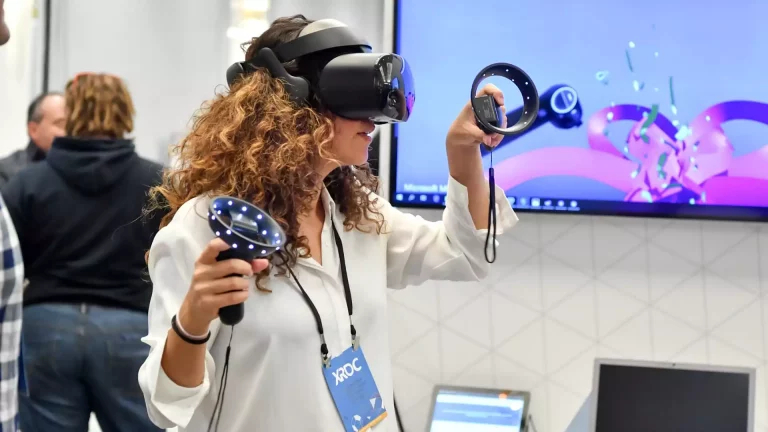
The past year has marked noteworthy growth in XR. And one subsector where this is particularly true is enterprise training. For those unfamiliar, this utilizes immersive technologies like VR to train and upskill enterprise employees. The technology’s levels of immersion can boost efficacy in memory recall and other key aspects of learning.
As new case studies continue to emerge around these benefits and proof points, XR enthusiasts are eager to identify use cases within their organization. But in the XR industry, no company is the same. Hardware and analytics advancements are shaping the future of how organizations leverage the capabilities of XR training. As more use cases diversify the use of XR training, leaders in the XR industry have expanded their reach to technical and safety training.
The XR industry thrives on collaboration. By sharing unique insights and new solutions for learning, teamwork between technology and learning experts is driving innovation. In that spirit, here are some of the wins and losses in enterprise XR we’ve observed over the past year.
Wins
1. Industry Growth
In 2023, headcount was up at major events like Augmented Enterprise Summit and Augmented World Expo – signifying a tangible example of the industry’s growth. As digital technologies shape the future of education, XR programs implemented in the enterprise space represent a longer trajectory – lifelong learning.
The sheer scale of XR projects has expanded due to technology improvements and accessibility. Hardware has become more enterprise-friendly, from price points to technological advancements to address unique and specific use cases. What benefits consumers, benefits the industry twofold. XR is entering a sweet spot of high-end technology at lower price points. With the third-party support of accessories, continued growth is fueling companies to incorporate new accessories to support XR experiences.
2. Hardware Advancements
Hardware advancements and accessories that made the biggest impact in 2023 share the common goal of improving multi-sensory learning experiences. The surge in wearable haptic feedback gloves is just one example of improved realism in XR experiences. Tracking body ergonomics opens new possibilities. With third-party support, the continued growth is fueling companies to develop new accessories to support the XR experience.
By taking a pragmatic approach to hardware advancements, XR training has shifted the conceptual understanding of what works best for learners. For example, in technical training, picking up virtual boxes with controllers is unnatural. Hand tracking is replacing controllers, making sure learners don’t build false muscle memory.
3. Industry Collaboration
By bridging the unique perspectives and expertise of XR companies and the top immersive learning developers, training content in 2024 will largely benefit from industry collaboration. From hardware advancements to better-integrated learning experiences, XR training’s improved agility is working faster to close skill gaps in various industries.
Losses
1. Unoptimized Curricula
In the world of XR, there’s always room for improvement. Organizations are learning not to underestimate what it takes to roll out a new project. Managing new tech, user data, and information at scale leaves some organizations asking how to integrate XR data with their existing systems. Unoptimized curricula have left users captivated with the VR experience while the learning objectives remain subpar.
AR and VR experts continue to relay an important takeaway about implementing these impactful technologies. While XR elevates the way people learn, the technology shouldn’t be a replacement for traditional modes of training. The most successful XR programs include foundational learning. XR provides hands-on training without interrupting operations and is best optimized in blended learning solutions.
2. Data Security
Many large organizations worry about where and how their data will be stored. Companies are worried about what might happen if they share too much information. Here’s the great news – XR data storage in 2024 is safer and more secure, plus working with reliable vendors can help with support.
Proof Points: Who’s Doing it Right?
Drilling down to some real-life examples, who is doing enterprise XR right? One example of real-world scenarios brought to life in VR is Cox Communications’ Field Safety Training. By showcasing the learning impact of haptic feedback, Cox Communications won Gold in Brandon Hall’s Excellence in Technology Awards for Best Advance in Augmented and Virtual Reality.
The winning elements of this multi-sensory VR program embrace a sandbox learning approach that allows Cox employees to practice tactile skills in real-world scenarios. By ensuring constant learning reinforcement with simulated consequences to error, XR programs complement existing training programs with strong curricula that focus on specific learning objectives. But that’s not where the silver lining stops. The best measurement of success is defined by learners. Cox surveys revealed that 90% or more of employees reported a boost in confidence rates, with 100% of learners wanting to see more VR experiences in their training curriculum. Scalable learning solutions transform the way organizations address safety procedures.
Some of the biggest e-commerce giants are incorporating customized XR programs to optimize their training programs to improve workforce efficiency. Between custom headset storage and hand tracking, efforts to advance AR are breathing new life into the XR industry. Behind the scenes, cutting-edge companies are developing new systems for streaming content from headsets to desktops, two-way communication between learners and instructors, and updating tracking features specific to vehicle operation training. These applications are split across two platforms: a desktop version where instructions can control the learner’s experience, and the second utilizing (Magic Leap) augmented reality glasses. With AR glasses, virtual obstacle courses are layered on top of what the learner sees to streamline the process of training. And we’re just getting started.
Looking Forward: What’s Next?
With XR, it’s less about reinventing the wheel and more about pairing the principles of learning with innovative solutions. By ensuring strong learning outcomes, organizations are enhancing their business strategy with XR. Predictions for XR in 2024 are set on three main areas of innovation:
1. Industry Growth
With more competition comes more opportunity. Affordable prices and tech advancements like improved graphics and extended battery life are just a few of the advantages that come with having more players in the game. Healthy competition will allow the industry to flourish. As new XR companies focus on enterprise solutions, immersive training is becoming more accessible and will continue to broaden its reach of XR learning globally.
2. Diverse Market
As the XR market continues to diversify, the world of corporate training could not be at a better advantage. The diverse market provides options for custom solutions, precisely tailored to unique training needs. With a better selection of products and a culture of ongoing innovation, organizations have better opportunities to optimize their training programs and translate to a workforce equipped with fine-tuned skills.
3. Focus on Technical and Safety Training
In 2024, XR will shift its focus to use cases offering comprehensive solutions for technical and safety training. This approach reflects a commitment to organizational development, addressing critical areas like ROI with sophisticated training metrics. Data-driven approaches to training will ensure that XR becomes integral to organizational growth, enhancing capabilities, and contributing to safer work environments.
Final Note
As a final note on the state of the XR industry, hardware advancements, innovative collaboration, and a shift in focus toward enterprise solutions are top of mind for a promising 2024. Everyone has something different to bring to the table.
 Nick Day is VP of Sales & Marketing at Roundtable Learning.
Nick Day is VP of Sales & Marketing at Roundtable Learning.






